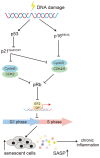Drug Delivery Strategies for Age-Related Diseases
- PMID: 39201377
- PMCID: PMC11354581
- DOI: 10.3390/ijms25168693
Drug Delivery Strategies for Age-Related Diseases
Abstract
Drug delivery systems (DDSs) enable the controlled release of drugs in the body. DDSs have attracted increasing attention for the treatment of various disorders, including cancer, inflammatory diseases, and age-related diseases. With recent advancements in our understanding of the molecular mechanisms of aging, new target molecules and drug delivery carriers for age-related diseases have been reported. In this review, we will summarize the recent research on DDSs for age-related diseases and identify DDS strategies in the treatment of age-related diseases.
Keywords: SASP; age-related diseases; drug delivery systems; p16INK4A; senescence-associated β-galactosidase.
Conflict of interest statement
The authors declare no conflicts of interest.
Figures









Similar articles
-
Preparation and application of pH-responsive drug delivery systems.J Control Release. 2022 Aug;348:206-238. doi: 10.1016/j.jconrel.2022.05.056. Epub 2022 Jun 8. J Control Release. 2022. PMID: 35660634 Review.
-
Extracellular Vesicle (EV) biohybrid systems for cancer therapy: Recent advances and future perspectives.Semin Cancer Biol. 2021 Sep;74:45-61. doi: 10.1016/j.semcancer.2021.02.006. Epub 2021 Feb 17. Semin Cancer Biol. 2021. PMID: 33609664 Review.
-
Implantable sustained-release drug delivery systems: a revolution for ocular therapeutics.Int Ophthalmol. 2023 Jul;43(7):2575-2588. doi: 10.1007/s10792-023-02637-x. Epub 2023 Jan 30. Int Ophthalmol. 2023. PMID: 36715956 Review.
-
Nano-, micro-, and macroscale drug delivery systems for cancer immunotherapy.Acta Biomater. 2019 Feb;85:1-26. doi: 10.1016/j.actbio.2018.12.028. Epub 2018 Dec 19. Acta Biomater. 2019. PMID: 30579043 Review.
-
Recent Advances in Metal-Organic Frameworks as Anticancer Drug Delivery Systems: A Review.Anticancer Agents Med Chem. 2021;21(18):2487-2504. doi: 10.2174/1871520621666210119093844. Anticancer Agents Med Chem. 2021. PMID: 33463479 Review.
References
Publication types
MeSH terms
Substances
LinkOut - more resources
Full Text Sources
Medical

